Por favor, use este identificador para citar o enlazar este ítem:
http://www.alice.cnptia.embrapa.br/alice/handle/doc/991067| Título: | Mycelial compatibility and aggressiveness of Sclerotinia sclerotiorum isolates from Brazil and the United States. |
| Autor: | KOGA, L. J.  BOWEN, C. R.   GODOY, C. V.   OLIVEIRA, M. C. N. de   HARTMAN, G. L.   |
| Afiliación: | LUCIMARA JUNKO KOGA, University of Illinois; CHARLES ROGER BOWEN, USDA - ARS; CLAUDIA VIEIRA GODOY, CNPSO; MARIA CRISTINA NEVES DE OLIVEIRA, CNPSO; GLEN LEE HARTMAN, UNIVERSITY OF ILLINOIS. |
| Año: | 2014 |
| Referencia: | Pesquisa Agropecuária Brasileira, Brasília, DF, v. 49, n. 4, p. 265-272, 2014. |
| Descripción: | ABSTRACT: The objective of this work was to evaluate the genetic diversity among Sclerotinia sclerotiorum isolates from Brazil and the USA, assess their aggressiveness variability, and verify the existence of an isolate-cultivar interaction. Isolate variability was determined by mycelial compatibility grouping (MCG), and isolate aggressiveness by cut-stem inoculations of soybean cultivars. Two experiments for MCGs and two for aggressiveness were conducted with two sets of isolates. The first set included nine isolates from the same soybean field in Brazil and nine from the Midwest region of the USA. The second set included 16 isolates from several regions of Brazil and one from the USA. In the first set, 18 isolates formed 12 different MCGs. In the second set, 81% of the isolates from Brazil grouped into a single MCG. No common MCGs were observed among isolates from Brazil and the USA. The isolates showed aggressiveness differences in the first set, but not in the second. Although aggressiveness differed in the first set, soybean cultivars and isolates did not interact significantly. Cultivar rank remained the same, regardless of the genetic diversity, aggressiveness difference, and region or country of origin of the isolate. Results from screening of soybean cultivars, performed by the cut-stem method in the USA, can be used as reference for researchers in Brazil. RESUMO: O objetivo deste trabalho foi avaliar a diversidade genética entre isolados de Sclerotinia sclerotiorum do Brasil e dos EUA, determinar sua variabilidade quanto à agressividade e verificar a existência de interação isoladocultivar. A variabilidade dos isolados foi determinada por agrupamento de compatibilidade micelial (ACM), e a agressividade dos isolados, por meio de inoculações, com corte da haste, em cultivares de soja. Dois experimentos de ACM e dois de agressividade foram realizados, com dois conjuntos de isolados. O primeiro conjunto incluiu nove isolados, do mesmo campo de soja no Brasil, e nove da região Meio?Oeste dos EUA. O segundo conjunto incluiu 16 isolados de várias regiões do Brasil e um dos EUA. No primeiro conjunto, 18 isolados formaram 12 ACMs diferentes. No segundo conjunto, 81% dos isolados do Brasil formaram um único ACM. Nenhum ACM comum foi observado entre os isolados do Brasil e dos EUA. Os isolados apresentaram diferenças quanto à agressividade no primeiro conjunto de isolados, mas não no segundo. Embora a agressividade tenha diferido no primeiro conjunto, as cultivares de soja e os isolados não interagiram significativamente. A classificação das cultivares permaneceu a mesma, independentemente da diversidade genética, da diferença quanto à agressividade e da região ou país de origem do isolado. Resultados da seleção de cultivares de soja, realizada pelo método de inoculação de corte da haste nos EUA, podem ser utilizados como referência para pesquisadores no Brasil. |
| Thesagro: | Soja Doença de planta |
| NAL Thesaurus: | Soybeans Plant diseases and disorders |
| ISSN: | 0100-204x |
| Tipo de Material: | Artigo de periódico |
| Acceso: | openAccess |
| Aparece en las colecciones: | Artigo em periódico indexado (CNPSO)  |
Ficheros en este ítem:
| Fichero | Descripción | Tamaño | Formato | |
|---|---|---|---|---|
| mycelial.pdf | 535,96 kB | Adobe PDF |  Visualizar/Abrir |









